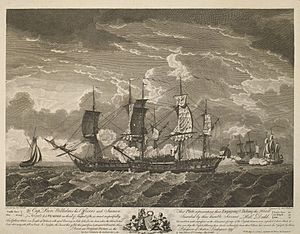Action of 10 August 1780 facts for kids
Quick facts for kids 10 August 1780 |
|||||||
|---|---|---|---|---|---|---|---|
| Part of American Revolutionary War | |||||||
 The action between HMS Flora & the French frigate Nymphe off Ushant on 10th August, 1780 by Dominic Serres |
|||||||
|
|||||||
| Belligerents | |||||||
| Commanders and leaders | |||||||
| Strength | |||||||
| 1 frigate 36 gun | 1 frigate 32 gun | ||||||
| Casualties and losses | |||||||
| 9 killed & 17 wounded | 1 frigate captured, 51 killed, 81 wounded 159 POW |
||||||
The action of 10 August 1780 was a small but important sea battle. It happened near Brest during the American Revolutionary War. This fight was between a Royal Navy frigate (a type of fast warship) and a French Navy frigate. It is believed to be the first time a new type of cannon, called a carronade, was used in battle.
The Battle of 10 August 1780
Getting Ready for Battle
On the afternoon of August 10, 1780, the British frigate HMS Flora (1780) was sailing near Ushant. Captain William Williams was in charge of the Flora, which had 36 guns. Besides its usual guns, the Flora also carried six new 18-pounder carronades. These were powerful, short-range cannons.
Through the misty weather, the Flora spotted two other ships about four miles away. One was a larger sailing ship, and the other was a smaller, faster boat called a cutter. As the Flora got closer, the cutter sailed away. But the larger ship waited, ready to fight.
The Fight Begins
When the two warships were about 200 yards apart, the French ship raised its flag and started firing. The Flora moved in closer. For over an hour, both frigates fired at each other fiercely. The Flora took some damage. It moved even closer so its carronades could be used. These cannons fired many small cannonballs (called grapeshot) that cleared the enemy's deck.
After another 15 minutes, the French sailors stopped firing their guns. They tried to board the Flora (jump onto its deck to fight hand-to-hand). But the Floras crew fought them off. Then, a box of cartridges exploded on the French ship, causing more damage and injuries. The Floras crew then boarded the French ship. Within moments, the French ship surrendered.
The captured ship was the French frigate La Nymphe. It was designed for 40 guns but only had 32. Its commander was Charles-Marie de Trolong du Rumain, a French knight. He sadly died that evening from his wounds. Command then went to Lieutenant Pennandref de Keranstret.
What Happened Next
The Floras guns were heavier than La Nymphes. The Flora had 18-pounder and 9-pounder guns, while the French ship had 12-pounder and 6-pounder guns. The new carronades on the Flora made a big difference in the number of people hurt. On the Flora, 9 sailors were killed and 17 were wounded out of a crew of 259. On La Nymphe, 55 sailors were killed and 81 were wounded out of a crew of 291.
After repairs at Portsmouth Dockyard, La Nymphe became part of the British Royal Navy in March of the next year. The British Navy Board was very impressed with how well the carronades worked in this battle. Because of this, carronades were soon put on many other Royal Navy ships.


